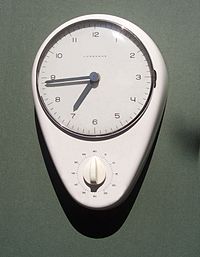Max Bill
After an apprenticeship as a silversmith during 1924–1927, Bill took up studies at the Bauhaus in Dessau under many teachers including Wassily Kandinsky, Paul Klee and Oskar Schlemmer from 1927 to 1929, after which he moved to Zurich.
[2] Bill is widely considered the single most decisive influence on Swiss graphic design beginning in the 1950s with his theoretical writing and progressive work.
Among Bill's most notable product designs is the "Ulmer Hocker" of 1954, a stool that can also be used as a shelf element, a speaker's desk, a tablet or a side table.
[4] He made spare geometric paintings and spherical sculptures, some based on the Möbius strip, in stone, wood, metal and plaster.
[5][6] His architectural work included an office building in Germany, a radio studio in Zurich, and a bridge in eastern Switzerland.
In 1982 he also entered a competition for an addition to the Neue Nationalgalerie in Berlin, built to a design by Mies van der Rohe.
Faculty and students included Tomás Maldonado, Otl Aicher, Josef Albers, Johannes Itten, John Lottes, Walter Zeischegg, and Peter Seitz.
In particular, he wrote books about Le Corbusier, Kandinsky, Ludwig Mies van der Rohe, and artistic theory.
[7] Bill executed many public sculptures in Europe and exhibited extensively in galleries and museums, including a retrospective at the Kunsthaus Zürich in 1968–69.
[10] After a liaison with Nusch Éluard, Bill married the cellist and photographer Binia Mathilde Spoerri in January 1931.
Bill died en route to a hospital after collapsing from a heart attack at Berlin Tegel Airport.



